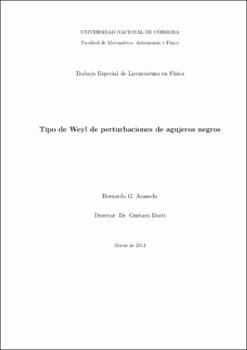| dc.contributor.advisor | Dotti, Gustavo daniel | |
| dc.contributor.author | Araneda, Bernardo Gabriel | |
| dc.date.accessioned | 2024-04-26T12:59:17Z | |
| dc.date.available | 2024-04-26T12:59:17Z | |
| dc.date.issued | 2014-03 | |
| dc.identifier.uri | http://hdl.handle.net/11086/551620 | |
| dc.description | Tesis (Lic. en Física)--Universidad Nacional de Córdoba. Facultad de Matemática, Astronomía y Física, 2014. | es |
| dc.description.abstract | En este trabajo se estudian las perturbaciones lineales de soluciones algebráicamente
especiales de las ecuaciones de Einstein, en particular, espaciotiempos tipo Petrov D. Se
analiza la estructura de autovalores y las direcciones principales nulas de la geometrı́a
perturbada. Se demuestra que el espaciotiempo no retiene en general la especialidad algebraica bajo la perturbación, teniendo cuatro direcciones nulas que resultan no-analı́ticas en
el parámetro perturbativo, y que representan una bifurcación de los dos pares coincidentes
del background. Los resultados son válidos para todo espaciotiempo tipo D perturbado,
en particular para la familia de agujeros negros de Kerr-Newman. Se aplican estos resultados a perturbaciones genéricas del agujero negro de Schwarzschild, demostrándose que
las nuevas direcciones principales no pueden corresponder a modos armónicos puros de la
perturbación, y obteniendo un efecto claro del modo par sobre la geometrı́a. | es |
| dc.description.abstract | In this paper we study linear perturbations of algebraically special solutions of the Einstein equations, in particular, spacetimes of Petrov D type. The eigenvalue structure and principal null directions of the perturbed geometry are analyzed. It is shown that the spacetime does not retain in general the algebraic specialness under perturbation, having four null directions which turn out to be non-analytic in the perturbative parameter, and which represent a bifurcation of the two coincident pairs of the background. The results are valid for all perturbed D-type spacetimes, in particular for the Kerr-Newman family of black holes. We apply these results to generic perturbations of the Schwarzschild black hole, showing that the new principal directions cannot correspond to pure harmonic modes of the perturbation, and obtaining a clear effect of the even mode on the geometry. | en |
| dc.language.iso | spa | es |
| dc.rights | Attribution-NonCommercial-NoDerivatives 4.0 International | * |
| dc.rights.uri | http://creativecommons.org/licenses/by-nc-nd/4.0/ | * |
| dc.subject | Relatividad general | es |
| dc.subject | Soluciones exactas | es |
| dc.subject | Teorı́a de perturbaciones | es |
| dc.subject | Física de los agujeros negros | es |
| dc.subject | Clasificación de Petrov | es |
| dc.subject | Espaciotiempos tipo D | es |
| dc.subject | Direcciones principales nulas | es |
| dc.subject | Campos lineales | es |
| dc.subject | General relativity | en |
| dc.subject | Exact solutions | en |
| dc.subject | Perturbation theory | en |
| dc.subject | Physics of black holes | en |
| dc.title | Tipo de Weyl de perturbaciones de agujeros negros | es |
| dc.type | bachelorThesis | es |
| dc.description.fil | Fil: Araneda, Bernardo Gabriel. Universidad Nacional de Córdoba. Facultad de Matemática, Astronomía y Física; Argentina. | es |





